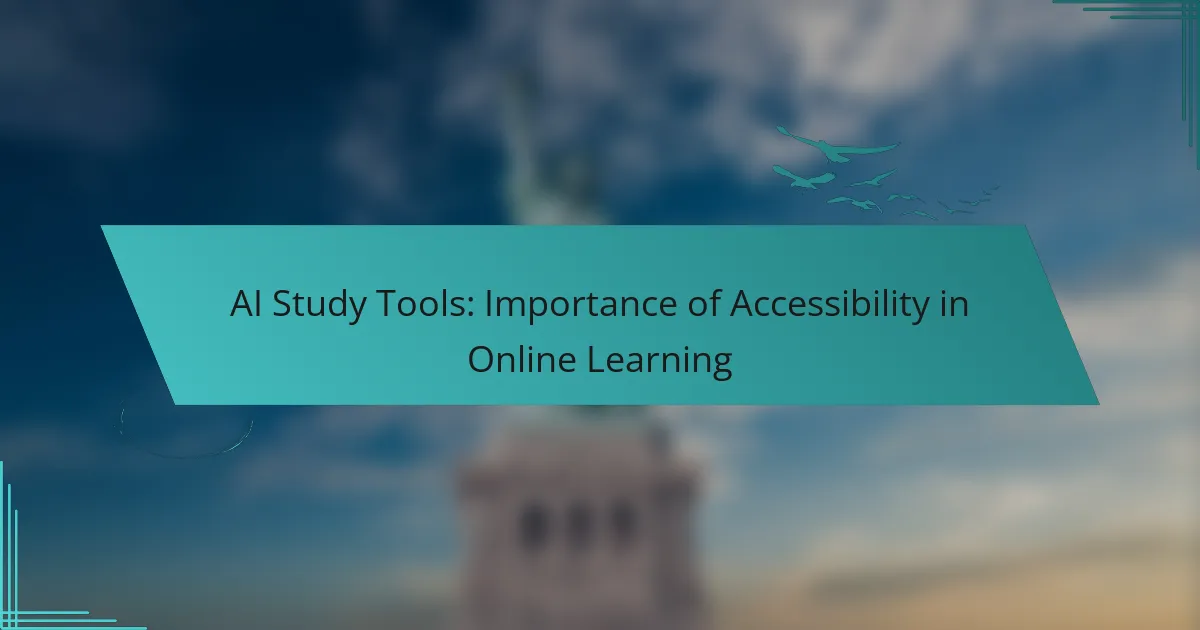AI study tools play a crucial role in enhancing accessibility in online learning by offering customized resources that address the diverse needs of students. By breaking down barriers, these tools ensure that education is inclusive, allowing all learners to engage effectively with the content and improve their overall success rates.

How Do AI Study Tools Enhance Accessibility in Online Learning?
AI study tools significantly enhance accessibility in online learning by providing tailored resources and support that cater to diverse learning needs. These tools help break down barriers, making education more inclusive for students with varying abilities and backgrounds.
Personalized learning experiences
AI study tools create personalized learning experiences by analyzing individual student data to tailor content and pacing. This customization allows learners to engage with materials that suit their unique preferences and comprehension levels, enhancing retention and understanding.
For example, a student struggling with math concepts may receive additional practice problems and explanations, while another student who excels may be presented with advanced challenges. This adaptability fosters a more effective learning environment.
Real-time feedback mechanisms
Real-time feedback mechanisms in AI study tools enable students to receive immediate responses to their queries and assignments. This instant feedback helps learners identify areas for improvement and adjust their study strategies accordingly.
For instance, if a student answers a question incorrectly, the AI can provide hints or resources to help them understand the concept better. This timely intervention can prevent misconceptions from taking root and encourages continuous learning.
Adaptive content delivery
Adaptive content delivery ensures that educational materials are presented in formats that best suit each learner’s needs. AI tools can modify text, visuals, and audio to accommodate different learning styles and preferences, making content more accessible.
For example, a student with visual impairments might benefit from audio descriptions of visual content, while another student may prefer interactive simulations. This flexibility allows all students to engage with the material effectively, regardless of their learning challenges.

What Are the Key Benefits of Accessible AI Study Tools?
Accessible AI study tools enhance the learning experience by ensuring that all students, regardless of their abilities, can effectively engage with educational content. These tools provide features that accommodate various learning needs, leading to improved participation and success rates.
Increased student engagement
Accessible AI study tools foster increased student engagement by allowing learners to interact with content in ways that suit their individual preferences. Features like text-to-speech, adjustable text sizes, and customizable interfaces can significantly enhance user experience.
For instance, students with visual impairments may benefit from audio descriptions, while those with learning disabilities might find interactive quizzes more engaging. By catering to diverse learning styles, these tools keep students motivated and involved in their studies.
Improved learning outcomes
When students can access materials tailored to their needs, learning outcomes tend to improve. Accessible AI study tools can help identify areas where a student struggles and provide targeted resources or feedback to address those gaps.
Research shows that students using accessible tools often achieve higher grades and retain information better than those who do not. This is particularly crucial in online learning environments where personalized support can make a significant difference.
Broader reach for diverse learners
Accessible AI study tools expand educational opportunities for a broader range of learners, including those with disabilities, language barriers, or varying educational backgrounds. By providing multiple means of access, these tools ensure that no student is left behind.
For example, features like multilingual support can assist non-native speakers, while simplified language options can help learners with cognitive challenges. This inclusivity not only benefits individual students but also enriches the learning environment as a whole.

Which AI Study Tools Are Leading in Accessibility Features?
Several AI study tools stand out for their commitment to accessibility, ensuring all learners can effectively engage with educational content. These tools incorporate features that support diverse learning needs, making online education more inclusive.
Microsoft Learning Tools
Microsoft Learning Tools offer a range of accessibility features designed to enhance reading and writing experiences. Tools like Immersive Reader provide text-to-speech capabilities, adjustable text size, and background color customization, which can significantly aid learners with dyslexia or visual impairments.
Additionally, these tools integrate seamlessly with Microsoft Office applications, allowing users to access accessibility features across various platforms. Educators can leverage these tools to create more inclusive lesson plans that cater to all students.
Google Classroom
Google Classroom includes several accessibility features that facilitate learning for students with different needs. Features such as voice typing and screen reader compatibility help students with disabilities participate fully in classroom activities.
Moreover, Google Classroom allows for easy sharing of resources and assignments, which can be tailored to meet individual learning requirements. Educators can utilize these features to ensure that all students have equal opportunities to succeed.
Read&Write by Texthelp
Read&Write by Texthelp is a powerful tool that provides a suite of accessibility features aimed at supporting learners with reading and writing difficulties. Its text-to-speech functionality, along with word prediction and vocabulary support, helps students better understand and engage with their coursework.
This tool is particularly beneficial in inclusive classrooms, as it allows for personalized learning experiences. Educators should consider integrating Read&Write into their teaching strategies to enhance accessibility and improve student outcomes.

What Criteria Should You Consider When Choosing AI Study Tools?
When selecting AI study tools, prioritize usability, integration capabilities, and cost-effectiveness. These criteria ensure that the tools meet diverse learning needs, work seamlessly with existing systems, and provide value for money.
Usability for diverse needs
Usability is crucial for accommodating various learning styles and abilities. Look for tools that offer customizable interfaces, intuitive navigation, and support for different formats, such as text, audio, and video. Features like screen readers and adjustable text sizes can enhance accessibility for users with disabilities.
Consider tools that provide user-friendly tutorials and customer support. A platform that is easy to use can significantly reduce the learning curve, allowing students to focus on their studies rather than struggling with technology.
Integration with existing platforms
Integration with existing educational platforms is essential for a smooth learning experience. Choose AI study tools that can easily connect with popular Learning Management Systems (LMS) like Moodle or Canvas. This compatibility allows for seamless data transfer and enhances the overall functionality of your study environment.
Evaluate whether the tool supports APIs or plugins that can integrate with other applications you already use. This can streamline workflows and minimize disruptions, making it easier to manage assignments, track progress, and collaborate with peers.
Cost-effectiveness
Cost-effectiveness is a key consideration when selecting AI study tools. Assess the pricing models, which may include subscription fees, one-time purchases, or freemium options. Determine what features are included at each price point to ensure you are getting the best value for your investment.
Additionally, consider the potential return on investment. Tools that enhance learning efficiency or improve grades can justify their costs over time. Look for discounts for students or educational institutions, as many providers offer reduced rates to make their tools more accessible.

How Can Educators Implement AI Study Tools for Accessibility?
Educators can enhance accessibility in online learning by integrating AI study tools that cater to diverse learning needs. These tools can provide personalized support, ensuring that all students, regardless of their abilities, can engage effectively with the material.
Training for educators
Effective implementation of AI study tools begins with comprehensive training for educators. This training should cover the functionalities of the tools, best practices for integration into the curriculum, and strategies for addressing the unique needs of students with disabilities.
Workshops and online courses can be beneficial, allowing educators to gain hands-on experience with the tools. Regular updates and refresher courses can help educators stay informed about new features and improvements.
Creating inclusive content
Inclusive content is essential for maximizing the benefits of AI study tools. Educators should design materials that are accessible to all students, using clear language, alternative text for images, and captions for videos.
Utilizing AI tools can assist in creating adaptive content that adjusts to individual learning styles. For instance, providing audio versions of texts or interactive quizzes can cater to various preferences and enhance engagement.
Monitoring and feedback systems
Establishing monitoring and feedback systems is crucial for assessing the effectiveness of AI study tools. Educators should regularly collect data on student performance and engagement to identify areas for improvement.
Feedback from students can provide insights into their experiences with the tools. Surveys and focus groups can be effective methods for gathering this information, allowing educators to make informed adjustments to their teaching strategies and content delivery.
